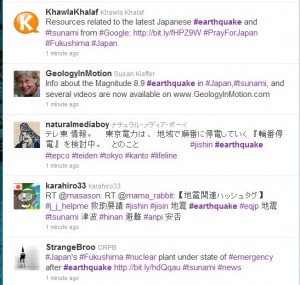 Revolutions, earthquakes, and tsunamis: What do they have in common?
Revolutions, earthquakes, and tsunamis: What do they have in common?
Answer: Social media
“What fascinated most Social Media analysts was the speed at which information traveled all over the world regarding the earthquake.”
Is it a coincidence , or simply the New Normal, that typically hot journalistic topics like violence and devastation are now being reported most effectively through Social Media rather than Traditional Media — at the same time that 33 Laney College students are actively participating in my online course Social Media for Journalists.
Our Facebook Group discussions are lively and revealing like the one evolving around the earthquake and tsunami in Japan that lead to this student’s coverage of the events and their reporting.
Mother Nature Attacks, Social Media Assists!
 Guest Post by Champa Mulchandani
Guest Post by Champa Mulchandani
Mother Nature is seriously upset. And to show us the extent of her unhappiness, she decided to throw an earthquake at Japan. You know she means business when it’s an 8.9 magnitude earthquake which is soon followed by a massive tsunami. If the earthquake hit any other country in the world, this situation would have been a horrendous one.
However, because Japan is one of the most technologically advanced countries whose architecture and infrastructure is designed with earthquakes in mind, the earthquake was unable to cause heaps of destruction.
But no matter how large a catastrophe, Social Media never fails to assist and connect. Phone lines may come crashing down, but Facebook and Twitter will be up and rollicking waiting to be used. And so it did. While reporting and giving viewers the most up to date news from north east Japan, they insisted on family and friends from around the world on utilizing all forms of Social Media to stay in touch with people in the earthquake hit Japan.
Japan hashtags trending
In the last 24 hours, the hash tags #Japan, #earthquake, #tsunami and #prayforjapan have been trending and how. CNN went on to display a number of tweets from all over the world where people explained their feelings towards the earthquake. While locals in Japan tweeted about how their homes swayed, how they were scared and how they were looking for family in parts of Japan where communication was down, people in Chile, were getting ready to be hit by the tsunami waves and thus, were expressing their fears. These chilling firsthand accounts not only gave the media an insight into how Social Media has not only become a source for news, but a diary even where users are able to convey their experiences.
 But when it comes to Social Media assisting and informing people of the earthquake, it was Twitter all the way. Most avid Tweeters received news of the earthquake via Twitter. And then realizing that there was no way of communicating with people in Japan any other way but through Twitter, Facebook and Skype. But Twitter didn’t just come in handy for people abroad; local Japanese citizens flocked to Twitter for aid and information. Non-Japanese speakers residing in Japan were all over Twitter looking up alerts, altered train schedules and even places for shelter.
But when it comes to Social Media assisting and informing people of the earthquake, it was Twitter all the way. Most avid Tweeters received news of the earthquake via Twitter. And then realizing that there was no way of communicating with people in Japan any other way but through Twitter, Facebook and Skype. But Twitter didn’t just come in handy for people abroad; local Japanese citizens flocked to Twitter for aid and information. Non-Japanese speakers residing in Japan were all over Twitter looking up alerts, altered train schedules and even places for shelter.
What fascinated most Social Media analysts was the speed at which information traveled all over the world regarding the earthquake. Tweeters, in and out of Japan, rapidly updated timelines; eyewitnesses used YouTube and uploaded videos by the minute of any visuals they had while Facebook pages were put up by the dozen asking for aid, funds and relief much before even the Red Cross could get on board to call on the world for help.
Google too, quickly gathered resources and launched their People Finder site for Japan as soon as the earthquake hit. And it seriously does rock – not as much as the earthquake though, thankfully. Presented with two options, to look or provide information, users can fill in necessary information regarding people they may be looking for. This information is added into a public registry which allows people to search for missing loved ones. Google clearly moved quickly with their site as it is not only available in English and Chinese, but in Japanese too.
Traditional media relies on social media
Ultimately, what Social Media did for the Japan earthquake was provide information so quickly that even news channels sought their help. This would explain why CNN promoted the use of Social Media and encouraged citizens of the world to hop on the Social Media bandwagon. What this ultimately tells us, as Social Media journalism students is simple: the power of Social Media cannot be underestimated and more importantly, besides connecting, it comes in handy during any or all catastrophes. We’ve seen how Social Media has created revolutions in the world. Today we witnessed Social Media come in a totally different dimension. It didn’t just allow people to stay in touch despite an earthquake and tsunami, but it also allowed us to stay informed.
Sadly, Social Media will not be able to save or protect citizens who are in harm’s way. Nor will be ever be able to predict and prevent earthquakes from occurring. But it certainly can assist when Mother Nature goes rather into frenzy with us.
In the meantime, our thoughts and prayers are with Japan. We’re sure they will come through it all stronger and more resilient.